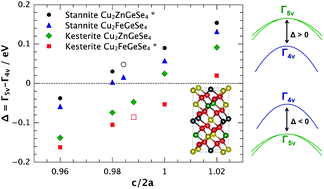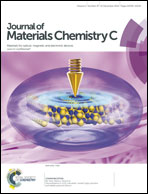Band convergence in the non-cubic chalcopyrite compounds Cu2MGeSe4†
Abstract
Inspired by recent theoretical predictions on band convergence in the tetragonal chalcopyrite compounds, we have explored the influence of the crystal structure on the transport and bandstructure of different quaternary chalcopyrites. In theory, a changing lattice parameter ratio of c/2a towards unity should lead to band convergence due to a more cubic and higher symmetry structure. In accordance with this prediction, the different solid solutions explored in this manuscript show a significant impact on the electronic transport depending on the ratio of the lattice parameters. An increasing lattice parameter ratio results in an increase of the carrier effective masses which can be explained by converging bands, ultimately leading to an increase of the power factor and thermoelectric figure of merit in the class of non-cubic chalcopyrite compounds Cu2MGeSe4. However, the calculations via density functional theory show that the critical value of c/2a, where band convergence occurs, will be different from unity due to symmetry and chemical influences on the band structure.


 Please wait while we load your content...
Please wait while we load your content...